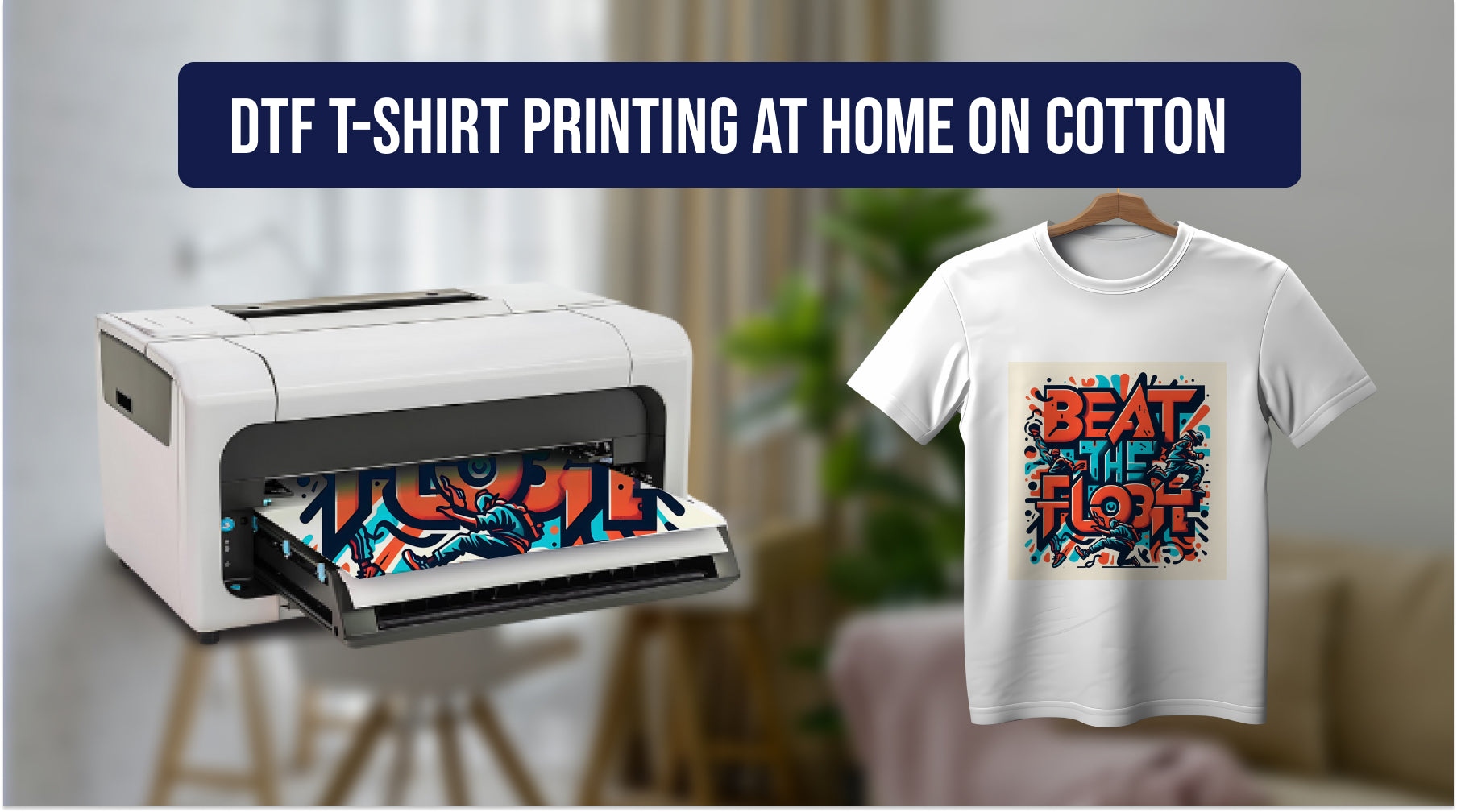DTF printing has been evolving as a versatile and cost-effective manner of creating custom T-shirts, particularly on cotton. People are getting desirous of doing business with the machinery and trying home-level printing. Be it for small businesses, hobbyists, or just adding custom touches to your wardrobe, DTF printing at home remains quite accessible and a valuable addition.
This blog will help you learn how to do DTF printing at home, some handy tips, the equipment needed, and the best practices of DTF printing on cotton.
What is DTF Printing?
The process of DTF printing involves printing a design directly onto a special film and transferring it onto the fabric by heat. Among all these methods, DTF printing on cotton is the best because the method gives you the capability of having vibrant colors and any kind of design on 100% cotton fabric.
Why Choose DTF Printing?
Home DTF printing has several positive elements but they are not found in traditional methods like screen printing or sublimation. Vectored quality prints with a soft hand, suitable with diversified fabrics, and inexpensive and simple machinery are a few to be named. This will be ideal for those who want to DTF print t shirts right at home.
Also Read: How to Achieve Flawless DTF Transfers with the Right Heat Press Technique
How to Do DTF Printing at Home
To start DTF printing at home, you’ll need the right equipment and materials. Here’s a step-by-step guide to help you get started.

1. Equipment and Material Collection
To print DTF transfers at home successfully, the following will be required:
- Home DTF Printer: For this purpose, a special DTF printer is required because special inks are placed in such a printer and it has accommodation for the film used for transfers.
- Transfer Film: Your design prints onto this material. It is capable of carrying the ink and powder used in the procedure.
- DTF Inks: They are pigment inks engineered specifically for printing with DTF. They provide good wash fastness and vibrant colors.
- Hot Melt Adhesive Powder: It is applied on the printed film; this would help your design adhere to the fabric.
- Heat Press: A heat press is what you're going to need for transferring the design from the film to the fabric since a standard iron used in a household wouldn't cut it.
- Cotton T-Shirt: Since you are focusing on DTF printing on cotton, go ahead and take a 100% cotton t-shirt for the best results.
2. Prepare Your Design
The next and first step in the actual printing is design preparation. For creating your design, you get the availability to make use of graphic design software such as Adobe Illustrator or CorelDRAW. Make sure the colors and details are ok for DTF printing on cotton. Once that is done, your design is ready. Now is the moment to proceed.
Also Read: Eco-Friendly DTF Transfer Inks: A Sustainable Choice for Printing
3. Print Your Design on the DTF Film
Put the DTF film into your home DTF printer. Ensure, though, that you have the right configurations for the printer depending on the film and the ink you're using. Print the design on the film, but be very keen on this point because you shouldn't smudge or spoil the print because it's coming out of the printer.
4. Apply the Adhesive Powder
Once the film has been printed with the design, the next procedure is the application of the hot melt adhesive powder. While the film is still wet, it is sprinkled all over with the adhesive powder. Apply over the whole area of the design. Shake off gently excess powder.
5. Curing the Adhesive
You will need to cure the powder using a heat press or an oven. Typically, this process will only take a few minutes, especially when under a particular temperature; hence, always ensure you adhere to the provided time and temperature stipulated for your substances. The adhesive will be tacky, not melted all the way.
6. Transfer the Design onto the Cotton T-shirt
Now that your design is ready, you will have to place it onto the cotton t-shirt. Place the t-shirt onto the heat press, then the DTF on the t-shirt, and top of the DTF, a Teflon sheet should be added. When doing DTF printing on cotton, use the recommended settings in terms of temperature, time, and pressure to press a design into the shirt to be done.
7. Peel the Film
Once the pressing has been done, it is then good and proper to allow the shirt some time to cool before peeling the film off. This is actually a cold peel, and its reason is that the design will be able to adhere properly to the material. After the removal of the film, you will be ready to have a good-looking, reliable print on your cotton t-shirt.
Also Read: How Much Does a DTF Printer Cost?
It is a great chance to create unique designs for cotton t-shirts and to be able to print DTF t-shirts at home. The process is usually very easy and requires minimal investment in some equipment. You can also produce equally professional quality, vibrant, and durable prints through the above steps for personal use or even in a business setup.
For more information on DTF transfers and to learn how you can get started with DTF printing at home, visit DTFNC. Discover everything you need to achieve professional results!
FAQs
Can you print DTF on 100% cotton?
Yes, DTF is considered one of the finest methods available when printing into 100% cotton. The bonding agents of this sort of adhesive powder in DTF do well with cotton, therefore creating bright and strong designs.
What is the best T-shirt printing method for cotton?
While there are several methods for printing on cotton, DTF printing on cotton is highly recommended due to its ease of use, color vibrancy, and ability to handle detailed designs. It's trendy among those who print t-shirts at home.
What fabric to use for DTF transfers?
DTF transfers work well on various fabrics, including cotton, polyester, and blends. However, DTF printing on cotton is particularly effective because the adhesive bonds well with the natural fibers, making it a popular choice for custom t-shirts.
Does transfer paper work on cotton?
Yes, traditional transfer paper can work on cotton, but it often lacks the durability and vibrancy that DTF printing on cotton provides. DTF printing is a more advanced technique that offers superior results than standard transfer paper.









2 comments
baju seragam kerja
Your article is very inspiring with high-quality content. We are sure that you will find additional useful information on our website. Come on, visit us at baju seragam kerja and we can collaborate with each other.
Warm Regard.
Ryan
can i press these on dark or light garments